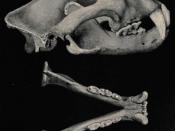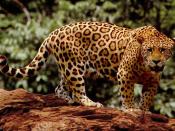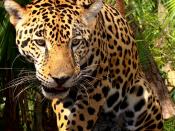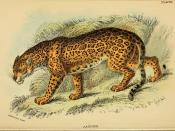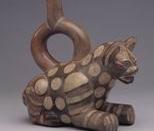The jaguar is a unique animal. Their size in length varys from 44-73 inches, their tail is short and thick and is 18-30 inches long. The weight in males varys from 125-250 lbs., in females, it's 100-200 lbs. The sexual maturity for a jaguar is 3 years. They can mate at any time of the year, but it's non-seasonal in the tropics;and early autumn in extremes of range. Gestation takes 93-110 days. They can give birth to 1-4 cubs, but they can only have cubs every other year. The habit of the jaguar is usually solitary, only getting together to mate during breeding season. Their diet mainly consist of ground living mammals. Some examples of these mammals are domestic stock, fish, frogs, turtles, small alligators, pecarries, turtle eggs, tapir, and deer. When in captivity the jaguar can live up to 22 years. The closest relative to the jaguar is the leopard.
The cubs of the jaguar are born with no father. The father leaves the mother after they are through mating. When they are born, the cubs are blind and weigh from 25-32 ozs. At two weeks, once their eyes open, They can begin to explore outside of the den. At one month the cubs go go outside the den and follow their mother around. When six months comes and the cubs have learned how to do things the way their mother does, they begin to hunt with their mother. At one year the cubs can now hunt for their own food. Even though they can hunt for their own food they still stay with their mother for a few years before finding their own hunting territory. By three years the cubs have learned enough to where they leave their mother to live on their own.
The jaguar's characteristics are very interesting. Jaguars like to stalk their prey by getting as close to it as possible without being noticed then they attack it. They usually hunt during the night because it's fur gives it great camouflage. Their great camouflage also makes them hard to find and hard to study. They are really good at hiding, making them hard to find, even during the day. They're good climbers, and when they get into the trees they can become great prowlers, hunting their prey. One of the jaguar's main specialties is fihing. They can use their tail as a lure for fish, once the fish sees the so-called lure the jaguar uses his paw to scoop the fish out of the water and catch it in his mouth. The jaguar is a very strong animal, but it can only snarl and growl to warn it's enemies because it can't roar. Another disadvantage for the jaguar is that it tires quickly, making it hard for it to catch fast food. The jaguar is also one of the few big cats that doesn't mind getting wet and is a good swimmer. His jaw is large and powerful looking for good protection. He is heavily built with a stocky appearance and sturdy legs. Their fur has a pattern of rings or rosettes of dark spots with a dark dot in the middle of the ring. They hate captivity and they aren't cats that were made to train for the circus.
The jaguars were subject to many myths, so I've picked 2 to randomly insert in my paper. Myth #1: "In exoneration of the jaguar the famous explorer and naturalist Humboldt tells of two indian children playing in a forest clearing. They were joined by a jaguar who bounded around them until it accidentally scratched the face of one child. The other seized a stick and smote the jaguar on the face; the wild beast slunk back into the jungle." Jaguars are very good at stalking their prey before a meal. One of their strategies is to follow close behind the prey before attacking. They can lay in a tree to wait for their prey, then stalk it from above. They also like to hunt at night because it's easier for them to hide while they stalk. They have been known to follow men because they trespassed on their territory. They can catch their prey just as good as they can stalk it. One of the ways to catch it, is obviously to stalk it first. Another way is by surprising its prey and making a quick attack. They can leap on their prey from trees, and a sudden rush or leap can bring down their prey. One of the best things they do is kill the prey. They can kill it easily by a bite on the back of the head, or throttled with a hold on the throat. To kill turtles they turn it on its back, rip its shell off, and devour it. One of the many unknown reasons why they kill is because they are very possesive of their prey.
Jaguars have a reputation to eat man, but you have to realize that there is always a reason for it. They only sometimes eat men, they are more man-killers than man-eaters. They are known a lot to eat hunters who have tryed to kill them for their fur. Men aren't one of the jaguars natural prey. They only kill men for three reasons: They're unable to catch their usual prey, they develop a man-eating habit because food is scarce, or they learned it from their mothers when they were just cubs.
The jaguars habitat isn't huge but its a cozy place for them to live in. Mainly they're found in central and south america as far as Patagonia. The largest jaguars are found in Mato Grosso. They can survive in an area of 3 miles if food's good. If food's not good they might need an area of 200 square miles. They can live in dense jungles and scrublands to reed thickets and shoreline forests. They will live in open country if grass and rocks offer enough cover for hunting and a reliable source of water is available.
Myth #2: "This one is supported by the account of an English explorer in Brazil who, hearing a great commotion one evening, found a jaguar perched on an anthill surrounded by about 50 furious pecarries. Inadvertently the jaguar lowered its tail which was immediately grabbed by the pecarries, who pulled the jaguar down and pulled it apart." The jaguar is almost hunted to extinction because of hunters. Most jaguar information is studied from zoos where they're in captivity. It is the largest american wildcat. It's the symbol of royalty to the south american indians. It's also the world's largest spotted cat. El Tigre is what the south americans call the jaguar. The soth american indians call it jaguara meaning: "carnivore that overcomes its prey in a single bound." The jaguar is strictly a carnivore, and it is more dangerous than a lion or leopard. Unfortunately, they might not be around much longer for us to experience their beauty.

